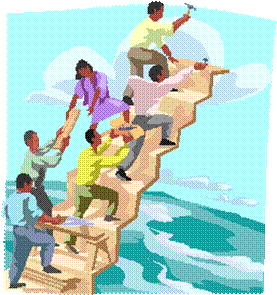"The commitment of creative people [from engineers to artists to managers]
is highly contingent, and their motivation comes largely from within.”
- Richard Florida
”The Rise of the Creative Class”
August / September 2006
Welcome again to The Artful Professional , a free newsletter for people who wish to bring greater creativity and meaning to their work.
This issue is dedicated to the Artful Project Manager and to anyone who wishes to know, appreciate and draw out the creative “characters” in themselves, in their teammates, and in their colleagues. Enjoy!
Sue Lebeck, M.S.,M.A.
Founder and Principal
www.working-arts.com
Get to Know Your Creative Characters

|
Every project is really a human story of mission and achievement. Artful Project Managers and other artful leaders view their project team members not so much as actors in a play, ready to adapt to any role given to them, but instead as what they actually are – real characters in an evolving story, characters who respond to events according to their passions, emotions, and sense of efficacy, achievement and appreciation.
To maximize the creativity and effectiveness of the real characters in your project story, begin by getting to know them. Beyond background and skill-sets, discover also how you might align their responsibilities to who they are. What environments suit them best? What situations inspire them? What elements of their work do they most enjoy? And what gives them juice, both inside and outside of work? |
Artful Team Meetings . When leading team meetings, invite not only status reports and issues to resolve, but also stories from the week. Story is the structure humans use to organize information, give meaning, and convey what is important to them. Using an attitude of “Appreciative Inquiry”, invite stories of challenge and achievement, stories of joy, and stories of experiment and lessons learned. Receive stories with an attitude of discovery, and of appreciation. Allow stories to effect how you work together, integrating these discoveries to improve processes, fine-tune assignments, share knowledge, make-meaning and build self- and group- esteem.
Artful One-on-Ones . When conducting one-on-one meetings with your team members, again invite stories. When listening to these stories, suspend judgment and evaluation and focus instead on learning more about this character. Invite not only reports of achievement and areas for self-development, but also invite poignant stories, and dreams of the future. Offer not only feedback and coaching, but also offer appreciative noticings, and your own best visions for the person before you. Hold these dreams and visions gently, allowing them to evolve and change. Let them inspire and inform your leadership – your planning, your coaching, and the day-by-day evolution of your professional work together.
Through these Artful Project Management practices, you will find your self better able to direct the human story of your project's success. You will be able to maximize the alignment between character participation and character passion. You will be able to re-structure responsibilities, and create opportunities which stimulate and support individual self-realization. By helping team members to develop not into high-quality conceptual employees, but instead into their own best selves, you will be rewarded with higher levels of engagement, excitement, creativity, and effectiveness. Share Your Thoughts
Share with us your artful insights. We'd love to read them and learn from you. To write us, e-mail sue@working-arts.com.
Pass it On
Share this newsletter freely to encourage the Artful Professional who lives within your friends and colleagues. To subscribe, unsubscribe, or ask a question, e-mail info@working-arts.com.
About the Founder
Sue Lebeck, M.S.,M.A., is Founder and Principal program designer and consultant for Working-Arts . Working-Arts® programs and perspectives are informed by Sue's background in both the arts and the sciences. With Working-Arts, thinking is informed by feeling, and creative inquiry is facilitated through model and method.
Sue holds graduate degrees in diverse fields, including computer science, and clinical psychology and creative expression. Her professional career includes nearly fifteen years in networking communications technology leadership and program management, and five years in expressive arts program development, education and counseling.
Sue has taught for several years in the Creative Expression graduate program at the Institue of Transpersonal Psychology ( www.itp.edu ) , is a guest instructor in Stanford University's ( www.stanford.edu ) Training and OD department , and is an affiliate of Dreamfish ( www.dreamfish.org ). Sue i s active in the South Bay Organizational Development Network ( www.sbodn.com ) and serves on the Board of the International Expressive Arts Therapy Association ( www.ieata.org ). |

|
|

